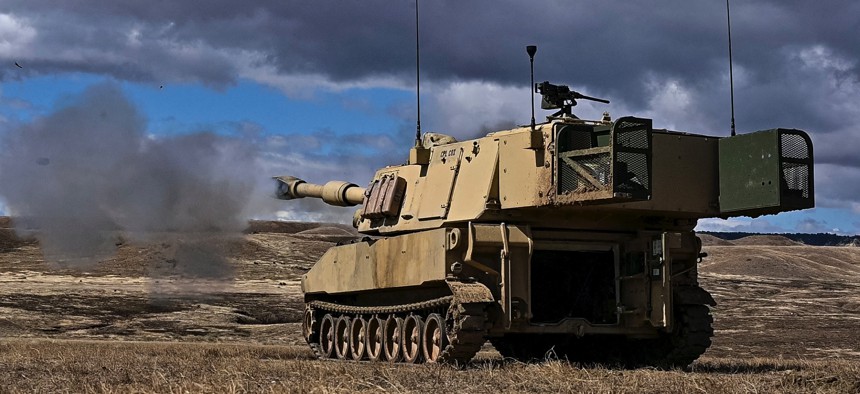
A U.S. Army M109A6 Paladin assigned to 3rd Battalion, 29th Field Artillery Regiment, 3rd Armored Brigade Combat Team, 4th Infantry Division fires during an artillery direct fire range at Fort Carson, Colorado, April 28, 2023. U.S. Army / Capt. Tobias Cukale
Army spending $1.5B on 155mm rounds to feed Ukrainian artillery
But the announcement also clouds the service’s production aspirations for the next two years.
The U.S. Army is spending $1.5 billion to buy components for 155mm shells and increase production capacity in response to Ukraine’s heavy use of the munitions in its defense against Russia, service officials announced Friday.
The money will help the service meet a monthly production goal of 80,000 by the end of 2025, the press release said. The service currently makes about 28,000 155mm shells a month, up from less than 20,000 in March.
That goal of 80,000 is less than the 85,000 announced in August by Doug Bush, assistant Army secretary for acquisition, and much less than the 100,000 announced in September by Bush and Pentagon acquisition chief Bill LaPlante. The six-figure monthly production target, Bush said last month, reflected “demand from Ukraine and the need to replenish ourselves and our allies.”
Asked to explain the reduction, an Army spokesperson said in an email, “Mr. Bush has consistently placed the goal of 100K at the end of calendar ’25, so this release does not reflect a change from what has already been put out publicly."
Army public affairs officials did not respond to further questions in time for publication of this article.
The U.S. has sent Ukraine more than two million of the shells, which can be fired by many, but not all, of the 155mm cannons donated to the wartorn country.
Last year, Russian units were estimated to fire as many as 600,000 shells per month. Ukrainian forces were firing far fewer—up 240,000 shells per month—but still strained U.S. and allied stockpiles and production capabilities.
The new Army money will buy primers, explosives, fuses, shell casings, and shell assembly. This includes 14.2 million pounds of TNT and IMX-104, 270,000 primers, 678,000 fuzes, 2.7 million Modular Artillery Charge System combustible cartridge cases, 1.6 million MACS propellant increments, and 451,000 M795/M1128 projectiles, the press release said.
The Army’s awards in part consist of multi-year procurement contracts, which the Pentagon pushed for in order to give industrial manufacturers the confidence to make investments in their production lines.
The contracts will go to locations in the U.S., including Tennessee, Pennsylvania, Arkansas, Iowa, and California; as well to companies in Poland, India, and Canada.





